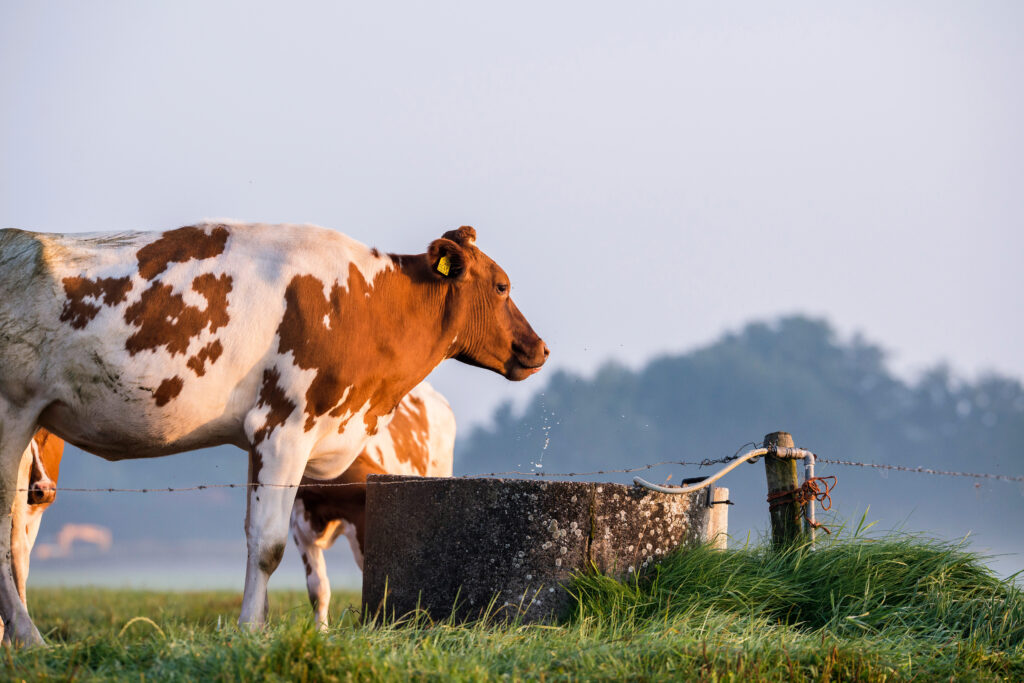Helping Livestock Beat The Heat This Summer

The best place to be when the sweltering summer weather arrives is inside with air conditioning, yet livestock outside of air-conditioned barns often need other ways to beat the heat.
Dr. Isabelle Louge, a clinical assistant professor at the Texas A&M School of Veterinary Medicine & Biomedical Sciences, says that while all livestock can cool down using shade, water, and fans, cooling strategies for livestock vary depending on the species and breed.
For example, shade is a common way to provide animals relief from the sun, but some benefit from the shade more than others.
“Access to shade particularly helps light-skinned animals from getting sunburned in areas with very little hair, such as the nose and around the eyes; white pigs, especially, should be kept under shade during the day since they are prone to sunburns,” Louge said. “Trees, run-in shelters, and open-sided canopies and roofs can serve as great sources of shade, or owners can consider only letting animals out to graze at night.”
While drinking water can significantly cool down animals as well, owners should be aware of how animals use water differently.
“Cows sit in watering holes to help them cool off, yet this method of cooling off can increase the moisture in a cow’s hooves, which make them soft and can lead to lameness from foot diseases like foot rot and abscesses,” Louge said. “It is better to discourage this behavior and provide other means to cool down animals with water.”
One effective way to cool down animals is to wet them periodically with cool – not cold – water, because, as Louge points out, cold water shocks the system and causes blood vessels near the skin’s surface to contract, reducing an animal’s ability to release heat.
“Most livestock species – with the exception of horses and donkeys – do not sweat to cool down, and because they can’t take advantage of this evaporative cooling naturally, physically wetting down animals and using a strong fan can create a breeze that encourages evaporation, mimicking sweating and cooling the animal,” Louge said.
Fans, in general, are a good addition to cooling strategies because the increased airflow helps animals lose heat through their skin, but Louge advises owners to take care when considering the presence of fans around their animals.
“It is important to make sure the animals do not get access to the fan blades or electrical cords, as these can be hazardous,” Louge said. “Owners should also make sure the fans are designed for high outdoor temperatures, as the motor can overheat and catch fire if they are not made for such temperatures.”
Other methods of cooling can be tailored more specifically to animals as well.
Animals with fiber or long hair – including wooly sheep, llamas, alpacas, angora goats, cashmere goats, and highland cattle – can keep cool easier once their hair is removed.
“The more hair or fleece a large animal has, the more likely it is to get heat stressed,” Louge said. “So for animals with very thick wool or hair, it is a good idea for owners to shear them multiple times in the summer to make sure they do not get too shaggy.”
Because of this, if possible, Louge suggests owners who live in warm areas not purchase animals that naturally have a lot of hair or wool; instead, owners should select a breed that is well-adapted to the local climate.
Finally, animals that rely on fermentation to digest their food – including cattle, goats, llamas, alpacas, horses, and donkeys – should not eat during the hottest part of the day, as this can overheat the animal.
“When these species eat a meal, the bacteria in their gut break down the food and produce heat as a byproduct,” Louge explained. “Because of this, it is best to feed animals early in the morning and in the evening when the sun is going down.”
No matter the animal, however, owners should bring their animals into the shade and provide water and a fan if they notice signs of overheating, such as fast breathing, panting, decreased activity level, slobbering, stumbling, and incoordination. Heat stress can worsen quickly, so Louge also strongly recommends calling a veterinarian to assess the animal and ensure they do not require more extensive supportive care to resolve the overheating issue.
Extreme heat can cause stress for livestock, and it is an owner’s responsibility to maintain their animal’s health. By personalizing cooling strategies to an animal’s species and breed, owners can ensure their livestock are able to withstand the stifling heat and remain comfortable throughout the summer.
Pet Talk is a service of the College of Veterinary Medicine & Biomedical Sciences, Texas A&M University. Stories can be viewed on the web at vetmed.tamu.edu/news/pet-talk. Suggestions for future topics may be directed to vmbs-editor@tamu.edu.


